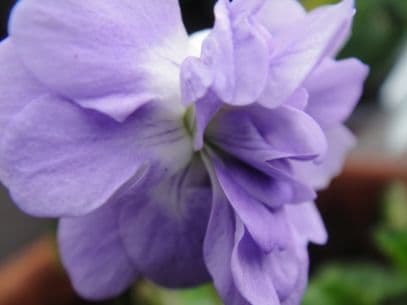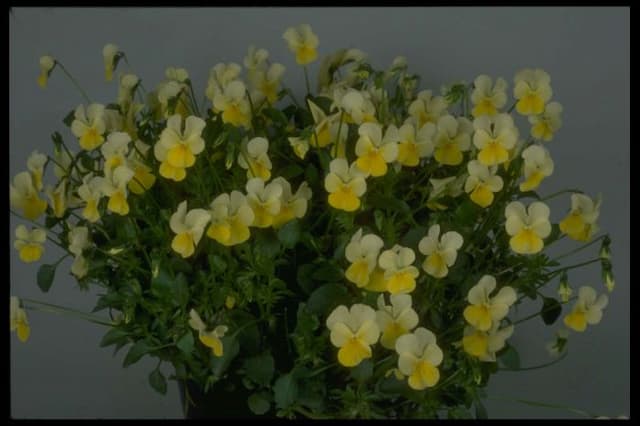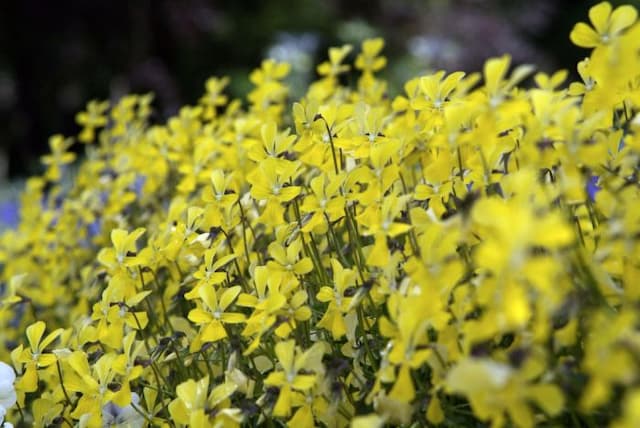Pansy Viola 'Parme de Toulouse' (dPVt)

ABOUT
The Viola 'Parme de Toulouse' is a charming and delicate flowering plant that is part of the violet family. It is particularly noted for its beautiful flowers that exhibit a unique and breathtaking appearance. These blossoms are typically characterized by their velvety texture and a stunning shade of purple that can range from soft lavender to a rich, deep hue. The petals may display a certain gradation of color, often with a lighter center that gently transitions to darker edges. Each flower is composed of five petals arranged in a classic violet shape: the two upper petals often stand upright, while the three lower petals may fan out into a harmonious spread. In some cases, the lower petals are adorned with delicate vein patterns, or they may be slightly ruffled at the edges, which adds to the overall charm and elegance of the bloom. The flowers sit atop slender stalks, gracefully hovering over the foliage. The foliage of the Viola 'Parme de Toulouse' is equally appealing with its lush green leaves. These leaves are typically heart-shaped, with a subtle sheen on the surface that can sometimes appear almost waxy. The edges of the leaves are softly scalloped, contributing to the plant's ornamental quality. Overall, the Viola 'Parme de Toulouse' exudes a certain romanticism and fairy-tale allure present in its delicate blooms and lovely leaves. Its appearance makes it a favored choice for gardeners looking to add a touch of elegance and color to garden beds, borders, or containers.
About this plant
 Names
NamesFamily
Violaceae
Synonyms
Parme de Toulouse Violet
Common names
Viola 'Parme de Toulouse'
 Toxicity
ToxicityTo humans
The common name of Viola 'Parme de Toulouse' is violet. Generally, violets are not considered toxic to humans and are sometimes used in edible preparations like salads and desserts. However, as with any plant, individual allergies or sensitivities can cause reactions, and it is always best to exercise caution and avoid ingesting plants unless you are certain they are safe and have been correctly identified.
To pets
The common name of Viola 'Parme de Toulouse' is violet. Violets are typically not considered toxic to pets such as dogs and cats. These plants are often regarded as safe and may even be found in some pet-friendly gardens. However, as with any plant, it is important to prevent pets from ingesting large quantities, as this behavior could potentially lead to gastrointestinal upset simply due to the ingestion of non-food items.
 Characteristics
CharacteristicsLife cycle
Perennials
Foliage type
Evergreen
Color of leaves
Green
Flower color
Purple
Height
0.5 feet (15 cm)
Spread
0.5 feet (15 cm)
Plant type
Herb
Hardiness zones
5
Native area
Europe
Benefits
 General Benefits
General Benefits- Ornamental Value - Viola 'Parme de Toulouse' adds aesthetic appeal to gardens with its vibrant purple flowers and lush green foliage.
- Easy to Grow - This plant is known for being low maintenance and easy to cultivate in a variety of soil types and climate conditions.
- Long Blooming Season - The plant typically enjoys a long blooming period, providing color and interest in the garden for an extended time.
- Attracts Pollinators - The flowers of Viola 'Parme de Toulouse' attract beneficial pollinators such as bees and butterflies, helping to support local ecosystems.
- Edible Flowers - The flowers of this viola are edible and can be used to garnish salads and desserts, adding both color and a mild flavor.
- Versatility in Landscaping - It can be used in a variety of landscaping settings, including borders, containers, and as ground cover, offering flexibility in garden design.
- Cultural Significance - Violas have been traditionally associated with symbolism and folklore, often representing love and remembrance.
 Medical Properties
Medical Properties- This plant is not used for medical purposes.
 Air-purifying Qualities
Air-purifying QualitiesThis plant is not specifically known for air purifying qualities.
 Other Uses
Other Uses- Viola flowers are edible and can be used to add a splash of color and a mild floral flavor to salads, desserts, and drinks.
- Viola petals can be crystallized with egg whites and sugar to create an elegant garnish for cakes and pastries.
- Viola blooms can be used in making natural dyes for textiles, imparting delicate shades of blue and purple.
- The flowers can serve as an ingredient in homemade potpourri, adding beauty and fragrance to the mixture.
- Viola plants can be used in crafts, such as pressing the flowers for use in various art projects like greeting cards and bookmarks.
- Viola 'Parme de Toulouse' can be planted as a companion plant in the vegetable garden, where they may help attract pollinators or repel certain pests.
- The leaves of violas can be used as a garnish for plating dishes, adding a touch of greenery and subtle flavor.
- Viola flowers can be infused into syrups, enhancing beverages and cocktails with their floral notes.
- They can be incorporated into ice cubes to create visually striking additions to drinks or punch bowls.
- Viola plants can be a decorative element for eco-friendly weddings, serving as part of biodegradable confetti or in natural bouquet arrangements.
Interesting Facts
 Feng Shui
Feng ShuiThe Violet is not used in Feng Shui practice.
 Zodiac Sign Compitability
Zodiac Sign CompitabilityThe Violet is not used in astrology practice.
 Plant Symbolism
Plant Symbolism- Modesty: Violas are small and often delicate flowers that don’t overwhelm with their presence, embodying a sense of humility and understatement.
- Innocence: The subtle shine and gentle shape of the viola petals represent purity and a return to simplicity.
- Love: In Victorian floriography, the viola, including the 'Parme de Toulouse', might be used to send messages of remembrance or love that is delicate and careful.
- Spiritual Wisdom: The viola has been associated with deep spiritual insights, perhaps due to its perennial nature and enduring bloom.
- Healing: Traditionally, the viola has been connected to healing, with various parts of the plant used in herbal remedies for different ailments.
 Water
WaterThe Pansy 'Parme de Toulouse' should be watered regularly, maintaining moist soil, especially during dry periods. It is important to avoid waterlogging, so ensure good drainage when planting. Water the plants with about 1 inch of water per week, distributing it evenly around the base of the plants. During the hotter summer months or in particularly dry climates, you may need to increase watering frequency to keep the soil consistently moist. Overhead watering can lead to leaf spot diseases, so it's better to use a soaker hose or water at the base of the plants to keep the foliage dry.
 Light
LightPansies 'Parme de Toulouse' prefer full to partial sunlight to thrive. They do best with at least six hours of direct sunlight each day, but during the hot midday, providing some shade can help protect the plants from extreme heat. An ideal spot would be one that receives morning sun and is shaded during the most intense afternoon sun.
 Temperature
TemperaturePansies 'Parme de Toulouse' thrive in cooler temperatures, with ideal growing conditions being between 40°F and 60°F. They can withstand a frost and survive in temperatures as low as 20°F, but they do not fare well in hot climates and will start to falter when temperatures consistently exceed 65°F to 70°F.
 Pruning
PruningPansies 'Parme de Toulouse' should be deadheaded regularly to encourage new blooms and extend the blooming period. Snip off spent flowers at the base of the stem. Furthermore, light pruning can be done to remove damaged or diseased foliage, which helps improve air circulation. The best time for pruning is late winter or early spring before new growth begins.
 Cleaning
CleaningAs needed
 Soil
SoilPansies like well-draining, rich soil with a pH between 6.0 and 6.5. Use a mix of peat, compost, and vermiculite or perlite for the best results.
 Repotting
RepottingPansies generally need to be repotted every 1-2 years to refresh the soil and encourage healthy growth.
 Humidity & Misting
Humidity & MistingPansies prefer moderate humidity levels; avoid overly dry or highly humid environments for optimal health.
 Suitable locations
Suitable locationsIndoor
Place in bright, indirect light and keep soil lightly moist.
Outdoor
Plant in partial sun, protect from extreme heat, ensure well-drained soil.
Hardiness zone
4-8 USDA
 Life cycle
Life cycleThe Viola 'Parme de Toulouse' begins its life cycle as a seed, typically planted in moist, well-drained soil in a location with partial to full sun exposure. Germination follows, and the seedling emerges with its initial set of leaves. As the plant grows, it forms a rosette of heart-shaped leaves, and once mature enough, it produces distinctive flowers, often with a notable purple hue characteristic of the 'Parme de Toulouse' variety. After the flowering stage, pollination occurs, often facilitated by insects, which leads to the development of fruit containing seeds. The plant either dies after completing its life cycle, if it is an annual, or goes into dormancy during unfavorable seasons if it is a perennial. Upon favorable conditions returning, if perennial, the plant will resume growth, either from existing structures or from the seeds it has disseminated, thus continuing its life cycle.
 Propogation
PropogationPropogation time
Spring-Early Summer
The Viola 'Parme de Toulouse', also commonly known as Sweet Violet, can be propagated by division, which is the most popular method. To propagate Sweet Violets by division, this should ideally be done in the fall or after the flowering season in spring. Carefully lift the plant from the soil and use a sharp knife or spade to divide the clump into smaller sections, each with a portion of the root system. Ensure each new section has at least one or two healthy shoots. Replant these divisions promptly, about 6 to 12 inches (15 to 30 centimeters) apart, at the same depth they were previously growing. Water them well to establish, and maintain consistent moisture for the best results. This method is effective as it helps to rejuvenate older plants while also expanding the garden's collection of Sweet Violets.









